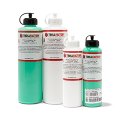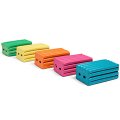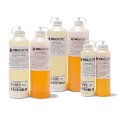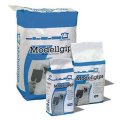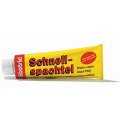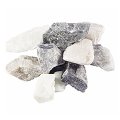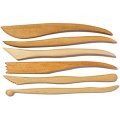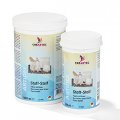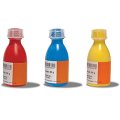Casting Resins & Aids
Information about casting resin & casting compound
Despite the fact that it was very often requested, we hesitated to add casting resin to our product line for a long time because it is such a complex material and because without comprehensive background information it is really hard to get a handle on it. In the meantime, we have assembled an extensive assortment which will become even larger in the future. On the following pages we attempt to describe our products and product groups in such a way that the various differences are easily ascertained so that your search for the right one will be that much simpler. The terminology that will be employed needs to be explained in some instances. We would therefore like to call your attention to the “small lexicon for silicone” (PDF file) in the section “Accessories for Silicone” under the heading “Moulding Materials” (left side of webpage).
Under the term “synthetic resins”, a group of materials is outlined which as a rule consists of two liquid or paste base components which, through an exothermic chemical reaction, create a more or less solid material. In the section “Adhesives”, we have already introduced examples of synthetic resins like, for example, the reaction adhesive based on epoxy resin. Synthetic resins are used for many other purposes as well like, for example:
• Moulding materials
• Casting resins
• Laminating resins (laminating glass, aramid or carbon fabrics or fleeces)
• Surface resins
• Fillers
• Adhesives
The synthetic resins that Modulor carries are, with few exceptions, ones used in making three-dimensional shapes by means of casting, moulding and for being used in the subsequent filling work. Information about moulding materials and fillers can be found in the corresponding sections under the heading “Three-Dimensional Moulds”. All of the casting resins that we have on offer will cure at room temperature. Curing through the heat of an oven is not required. In terms of their attributes and possible uses, the casting resins vary quite a bit. In the hand worker sector, the following areas of use are differentiated:
• Making moulds
• (Re)production of models and shaped pieces
• Producing materials for panels and sheets
• Casting construction pieces
• Making tools (punching, embossing, deep-drawing…)
We have, for the time being, limited our product range to the first three areas of use. In doing so, we differentiate between the following groups which have different attributes with respect to colour, transparency, shrinkage, solidity, etc.:
• Unsaturated polyester casting resins (UP)
• Polyurethane casting resins (PUR)
• Elastic polyurethane casting resins (PUR) – can also be used as an elastic moulding material.
• Gypsum/Acrylic casting resins (Acrystal)
In addition, more materials can be found under the heading “Three Dimensional Moulds” which can be worked with using casting procedures but which, for structural reasons, are not included in the group “Casting Resins”:
• Plaster materials (plaster and plaster-based casting materials)
• Moulding materials (e.g. silicone)
The following chart serves to present an overview of the basic differences distinguishing the various casting resin groups.
Comparison of casting resins
| Attributes of the components/processing | rigid polyurethane- casting resins (PUR) |
elastic polyurethane- casting resins (PUR) |
unsaturated polyester- casting resins (UP) |
Epoxy- casting resins (EP) 3) |
Gypsum/Acrylic- casting resins (Acrystal) |
| The plastic category | Duroplast | Elastomer | Duroplast | Duroplast | Synthetic gypsum/acrylic resin |
| linear shrinkage | slight | slight | very much | extremly slight | no shrinkage |
| Shelf life (minimum) | 6 - 12 months | approx. 12 months | 3 - 6 months | 6 - 12 months | 24 months |
| Toxicological/hazard info | as a rule, hazardous label required | as a rule, hazardous label required | hazardous label required | hazardous label required | hazardous label NOT required |
| Price | inexpensive | inexpensive | reasonably priced | expensive | inexpensive |
| Attributes of the material when cured | |||||
| Transparency | as a rule opaque 1) | as a rule transparent | transparent | as a rule transparent | opaque |
| Heat resistance | as a rule very little | as a rule very little | very little | as a rule very little | very little |
| UV resistance | only with additives 1) | only with additives 1) | only with additives 1) | yes | yes |
| moisture resistance (fresh water) | yes | yes | yes | yes | conditional 2) |
| Comments | |||||
| Special features |
|
|
|
|
|
| Intended uses | reproduction, engineering purposes | moulding and reproduction | reproduction | reproduction, engineering purposes | reproduction, lamination |
All the information refers primarily to the materials on offer at Modulor.
1) at Modulor there are transparent, UV resistant PUR and polyester casting resins
2) Acrystal products can withstand weathering but are not suitable for long term exposure to water
3) Will only be available at Modulor sometime in the future.
Attention: The following information and guidelines refer primarily to the duroplasts and elastomers found in the chart above. Comprehensive information about gypsum/acrylic casting resins (acrystal) can be found in the section Gypsum/Acrylic Materials.
Storage and Shelf Life: Resins and hardeners cannot be stored forever. Normally, when properly stored (unopened original package kept at between 15 and 25 °C), they will last between 6 and 12 months, although we have been told by people in the business that they have actually had successful results with 10 year old products. We can, however, not guarantee that that will always be the case!
Safety at work: No matter which casting resin is used, the preparations for the work, the necessary aids and the measures taken regarding work safety are always the same. The work area should be clean, large enough and well ventilated (work by an open window!). There should be no open fire.
Because contact with the skin can cause allergic reactions and any swallowing can cause serious health problems, gloves should be worn and food and the like kept at a safe distance. You should particularly avoid contaminating door knobs, light switches and other such often handled things. If the mixed resin or its components should happen to be swallowed or land in an eye (wear protective goggles!), a doctor should be consulted and the eyes should be immediately and thoroughly (10 to 15 minutes) washed out with cold water. We will gladly supply you with safety data sheets for each of the individual products.
Treatment: The following aids will be necessary for making any work that much easier and quicker:
• a substrate (enough newspaper to cover the working area)
• disposable gloves made of latex
• many rags for wiping up any droppings
• a clean, dry measuring cup, disposable syringes and an exact scale for precise measuring of the individual components
• wooden stirring spatula – or even better, a drill with a stirrer
• a clean, dry mixing cup for mixing the resin
• a dust/particulate mask(especially when working with polyester casting resin because the styrol that it contains is corrosive to mucous membranes!)
The resin and hardener should be completely mixed together in a clean, dry container according to the given mixing ratios (based on the weight) making sure that none is left stuck to sides of the container. Depending on the amounts involved, the mixing of the two components can be done by hand with a stirring spatula or through the use of a drill and an appropriate metal stirrer. In order not to negatively effect the precision of the mould, care must be taken that as few bubbles as possible are produced during this process. If the metal stirrer and drill are to be used, the slowest possible drill speed should therefore be chosen.
The working times given for each individual product are based on work done at room temperature. The times begin immediately at the moment that the two components are mixed together. In so far as the working time allows, you should let the already stirred resin aerate for a short time before pouring. In the case of higher viscosity casting resins, it is advisable to evacuate the mixture in a vacuum so that any air bubbles can escape. A markedly larger container must be chosen for such a resin mix because the material will expand considerably in a vacuum (see “vacuum device” in the little lexicon for silicone). If no vacuum device is available, the mixture should be poured from a height of from 20 to 30 cm in a thin stream over a spatula so that the air bubbles will thereby burst. Really persistent bubbles can also be burst with a pin or needle. When pouring, you should begin at the deepest part of the mould and allow the mixture to slowly rise.
The mould to be used must first be treated with a realease agent so as to avoid having it stick to the moulded piece whereby the subsequent de-moulding would be much more difficult. Silicone moulds are self releasing and must not necessarily be coated with a release agent. In order to lengthen the service life of a silicone mould, we recommend that you always use a release agent in cases where aggressive media are being poured. Porous moulds (e.g. wooden) must be sealed before applying the release agent. For this work, methyl cellulose or concentrated soap brine can be used.
Resin and hardener components for casting resins harden in a heat developing, “exotherm” reaction. The amount of heat produced is dependent on the size of the poured piece. The larger the poured piece, the hotter the mixture. Very high temperatures during casting should, however, be avoided. They not only shorten the service life but cause markedly more shrinkage as well and can even, in extreme instances, ruin the poured material completely. Polyurethane casting resins, for example, are not especially temperature resistant. When working with PUR quick casting resin, temperatures over 100 °C can be produced when an extremely large amount is poured at one time. In order to prevent that, either more separate steps must be employed and/or the resin must be mixed with the proper filler material.
After the de-moulding time has elapsed (see the chart “Casting resins – a comparison of our products”) the de-moulding process can begin. Casting resin does not attain its final physical attributes until at least a few days have passed. This hardening time can normally be reduced by means of exposing the piece to an external heat source for a number of hours.
If aggressive media (polyester, PUR or epoxy resin) are poured in a silicone mould, the mould should be allowed to air out for an adequate time after de-moulding because the chemicals contained in the media can lead to the mould becoming brittle. This can be done a lot faster and more completely by putting the mould over night in an oven heated to 60 °C.
